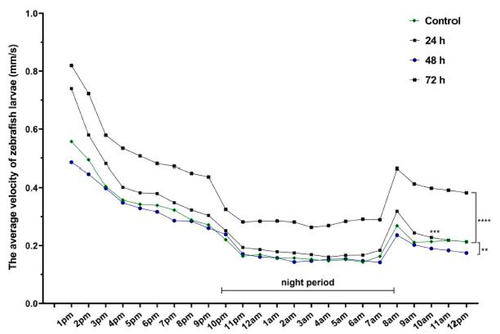- Title
-
Preliminary Results Regarding Sleep in a Zebrafish Model of Autism Spectrum Disorder
- Authors
- Robea, M.A., Ciobica, A., Curpan, A.S., Plavan, G., Strungaru, S., Lefter, R., Nicoara, M.
- Source
- Full text @ Brain Sci
|
Schematic diagram of VPA exposure in zebrafish embryos. VPA administration started in the first hours post-fertilization and ended after 24 h for Group 2, 48 h for Group 3 and 72 h for Group 4. Time of evaluation and behavioral tests are mentioned. |
|
Architecture of the mazes and the main areas of it for social interaction test (left) and aggression test (right) where GZ = group zone, IZ = individual zone and EZ = empty zone. |
|
The total distance swam by 6-day-old zebrafish larvae recorded during 24 h (n = 30). Group 1, control; Group 2, group exposed for 24 h to VPA; Group 3, group exposed for 48 h to VPA; and Group 4, group exposed for 72 h to VPA. The data is represented as average ± SEM. Anova and Tukey post-hoc tests, p < 0.05 was considered to be significant. The experimental groups were compared to control group, where **** p < 0.0001. PHENOTYPE:
|
|
The average velocity of 6-day-old zebrafish larvae recorded during 24 h (n = 30). Group 1, control; Group 2, group exposed for 24 h to VPA; Group 3, group exposed for 48 h to VPA; and Group 4, group exposed for 72 h to VPA. The data is represented as average ± SEM. Anova and Tukey post-hoc tests, p < 0.05 was considered to be significant. The experimental groups were compared to control group, where ** p < 0.01; *** p < 0.001 and **** p < 0.0001. PHENOTYPE:
|
|
Results of time spent moving parameter (active status) of 6-day-old larvae recorded during 24 h (n = 30). Group 1, control; Group 2, group exposed for 24 h to VPA; Group 3, group exposed for 48 h to VPA; and Group 4, group exposed for 72 h to VPA. The data is represented as average ± SEM. Anova and Tukey post-hoc tests, p < 0.05 was considered to be significant. The experimental groups were compared to control group, where ** p < 0.01; **** p < 0.0001. PHENOTYPE:
|
|
A pentagon depicting the changes in sleep parameters following VPA administration. All parameters are depicted as ratios of Group 1 (set as 1). Group 1, control; Group 2, group exposed for 24 h to VPA; Group 3, group exposed for 48 h to VPA; and Group 4, group exposed for 72 h to VPA. PHENOTYPE:
|
|
The amount of time spent by zebrafish groups during the social interaction test. Group 1, control (n = 30); Group 2, group exposed for 24 h to VPA (n = 24); Group 3, group exposed for 48 h to VPA (n = 24); and Group 4, group exposed for 72 h to VPA (n = 22). The social behavior was measured as the time spent by fish in the close to the group area. The data is represented as average ± SEM. Anova and Tukey post-hoc tests, p < 0.05 was considered to be significant. The experimental groups were compared to control group, where * p < 0.05, ** p < 0.01 and **** p < 0.0001. PHENOTYPE:
|
|
The main parameters of locomotor activity during the social interaction test. Group 1, control (n = 30); Group 2, group exposed for 24 h to VPA (n = 24); Group 3, group exposed for 48 h to VPA (n = 24); and Group 4, group exposed for 72 h to VPA (n = 22). Active status parameter represents the time spent moving by fish being active and stationary status the time spent in inactivity. The data is represented as average ± SEM. Anova and Tukey post-hoc tests, p < 0.05 was considered to be significant. The experimental groups were compared to control group, where * p < 0.05 and *** p < 0.001. PHENOTYPE:
|
|
The amount of time spent by zebrafish groups during the aggression test. Group 1, control (n = 30); Group 2, group exposed for 24 h to VPA (n = 24); Group 3, group exposed for 48 h to VPA (n = 24); and Group 4, group exposed for 72 h to VPA (n = 22). The data is represented as average ± SEM. Anova and Tukey post-hoc tests, p < 0.05 was considered to be significant. The experimental groups were compared to control group, where * p < 0.05. PHENOTYPE:
|









